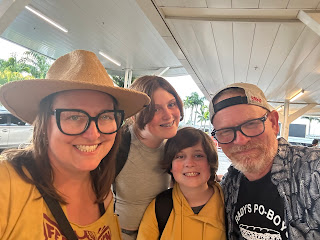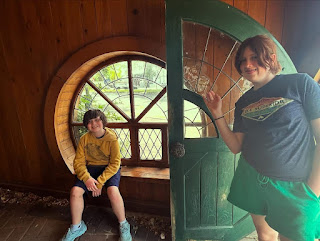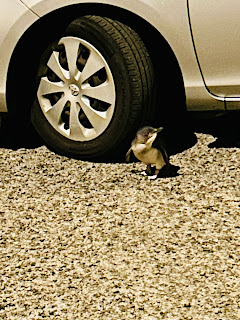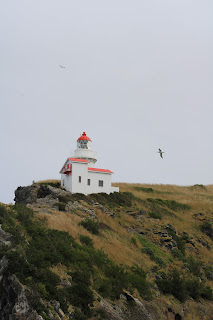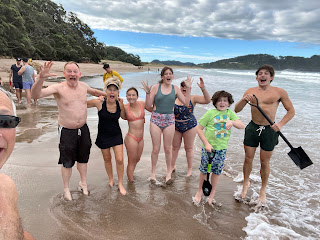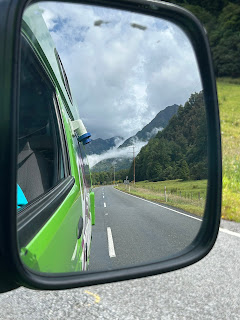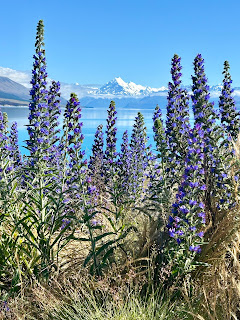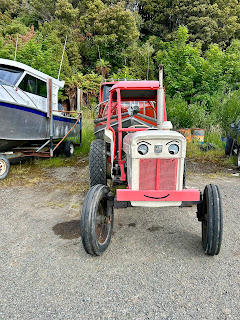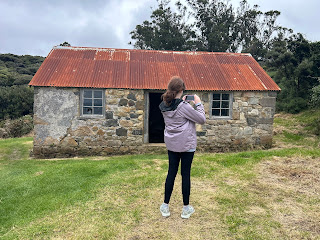New Zealand. For fifteen days over the Christmas and New Year's holiday our family crossed the country while caravaning with friends in a lime-green Toyota Campervan. Dubbed "Jucy" by the quirky rental company with whom we booked it, our trusty steed was a self-contained mini-home on wheels. Below are my reflections on our adventure five days after our return, written while emerging from jetlag.
With its natural geography and human architecture, New Zealand packs Canada, the U.S.A., and Mexico into two long islands that together are about twice the size of Florida and kinda similar in shape. In one morning you can role from coastlines that might remind you of Central California or Jalisco, to rolling fields of corn or livestock that would be right at home in Wisconsin or Kentucky, and onward into the kind of awe-inspiring mountains you might find in British Columbia or Oaxaca. All while rambling along the left lane of winding narrow country roads often given highway titles and few shoulders, with one lane bridges where a sign at each end informs you whether you or the other guy have the right-of-way. Both New Zealand's big and smaller cities embody buildings that you might find all over North America as well - with larger downtowns made of stately stone structures that would be right at home in London, Toronto, or Vancouver, sitting alongside the gleaming curves of 21st century glass skyscrapers, and their slightly smaller and more weathered concrete box counterparts - Auckland reminding me of my old neighborhood in Guadalajara with its hodge podge assortment of eras, stories, grandeur, and weathered disrepair. Smaller town's main streets are often flanked by long rows of cynderblock businesses with tin roofs and faiding paint, much like you'd find rolling through the Mexican states of Guanajuato or Michoacan. Inland neighborhoods of modest country ranch homes would be right at home in, say, suburban Iowa, and small victorian houses reflect those of older seaside neighborhoods on North America's West Coast.
Dotted along our Southerly route from the northern part of the North Island to the southern tip of the South Island were many rich stops along the way: Auckland, where the All Blacks Experience gave us a high-tech, crash-course immersion into one of the world's most storied rugby teams, including a practice hall where a computer measured our kicks and throws with a real team ball, and a room-length screen projected the team performing the Haka, with you standing in front of them as the slightly nervous opposing squad;
Hot Water Beach where shovel rentals provide the opportunity to dig a family-sized hole that becomes an instant jacuzzi, and shifting tides can shift your soak from 110 to 70 degrees;
Hobbiton, where lush rolling green hills one might find in America's Midwest are dotted with relics of the blockbuster movie trilogy, Lord of the Rings, and I discovered what must be at the forefront of every Hobbit's dream - New Zealand's meat pies.
Rotorua, a smaller-sized city built atop geothermal geysers and hotsprings that looks a bit like if you maybe plunked Bozeman, Montana smack on top of Yellowstone National Park. Imagine if you had a bubbling hotspring at the end of your cul-de-sac or Old Faithful outside your favorite restaurant's window... that's Rotorua. Populated by a Maori majority that welcomed us into their native culture via a Te Puia dining, theater, and geyser viewing evening that mixed history and humor with the Haka, Ritchie Valens, and Metallica, they told the tale of their sailing voyages across Polynesia to this very spot, where several hundred years later they dug in against the British to secure the prominent position they hold in New Zealand society today;
Waitomo, surrounded by caves and a canyon where tiny "glow worm" insects light up dark spaces in a magical display of fairy lights;
Paparoa National Park, that looks a bit like Mexico's cliff-laiden Pacific Coast, if the latter were made of cartoonish piles of stone pancakes with switchback trails bursting with tropical flowers and dandelions;
Kaiteriteri, toward the north tip of the South Island, where we soaked up the sunny beachside vibes of a 4th of Julyesque style Kiwi Christmas, with scores of Santa inflatables playing sous chef next to summer BBQs;
Arthur's Pass, the route over the South Island's mountain spine where, much like Glacier National Park in the U.S., lush rainforest gives way to grassy highlands, but here packs of the world's only Alpine parrot, the Kea, make mischief stealing tourist's cafe patio breakfasts and chewing the antennas off their cars;
Lupine flowers, seas of them in purple and pink, flooding meadows and road shoulders from the central mountains to the coast;
Kura Tawhiti, where our interpretive hike through a baren and boulder-laden highland landscape introduced us to the fact that a man-killing bird - a giant Eagle - did in fact exist and ruled those very skies until the Maori drove it to extinction not long before European arrival;
Queenstown, New Zealand's answer to Telluride or Jackson Hole, where adrenaline junkies pining for a starring role in a Red Bull ad bunjee jump, catapult, parasail, zipline, and luge their way from the tops of canyons and mountains, and an array of mid and high range restaurants, clothing, and gear stores anchor some of the livelier nightlife we found on either island;
Milford Sound, its towering fjords so majestic they defy any photographer's lens or poet's pen, with dozens of endless waterfalls literally pouring from the clouds with glacial blue waters the color of topaz;
Stewart Island, off the tip of New Zealand's southern-most coast, where the Antarctic breezes mix with a quirky mix of multigenerational fisherfolk and the colorful end-of-the-roaders that can often be found on the fringes of the civilized world, and Kiwi birds rule the island's nightime hours, strolling along like pondering old people on its forest trails, road shoulders, and campground fields, while blurting out sleep-jostling calls that sound something like R2D2 on a quest for love;
Oamaru, where a local wildlife charity has literally set up stadium-style seating, complete with a VIP section, to view the sunset arrival of the world's tiniest penguin, the Little Blue, with colony members hopping from the frothy Pacific Ocean then waddling past snoring seals right through the audience into tunnels between our seats to their nests beyond;
and on our last afternoon, the Otago Peninsula, where giant Albatrosses sail past a cliff top lighthouse, clearly revelling in gail-force shorewinds that send their ten foot frames wizzing by that light like straffing fighter planes.
Much of what I just described was anchored in New Zealand's natural wonders, many of which probably deserve honorable mention in the best Wonders of the World. Our immersion in the country's nature was rich, via a campervan culture that appears rooted in the country's human soul. Thousands of Kiwis, as New Zealanders are nicknamed, spend their holidays in campervans or trailors, rolling between "freedom camping" sites located in darn near every municipality, where bathrooms are provided and the fee is free. Taking in the full scope of one of the most beautiful countries in the world can be done on the cheap, if you're willing to pay a few bucks for a shower now and then at a community swimming pool, can endure the dampness of a fair amount of rain between pockets of elusive sunshine, and are up for drying your wet clothes at a sidewalk laundromat, where, yup, you heard that right, you can literally lean out your car window and stuff your laundry into a washer and dryer.
It also may help if you are comfortable around introverts... I say that last sentence with full disclosure - I am an extrovert, to the point I could very well be a highly annoying human being to anyone who wishes to just keep to themselves. Part of that comes from having to straddle a variety of cultures and places as a kid - a survival technique really, part of it might be spending the better part of three decades getting to know 100+ new students with each passing school year, and part of it is just baked into who I am. I like to strike up conversations with the folks I share a space with. I'll also add that our family spent a good deal more time on New Zealand's South Island than its North, and in its rural spaces rather than its urban. I am going to make a wager though. Your average Kiwi is more introverted than their American or Australian counterpart.
Auckland, the country's economic hub in the near sub-tropical North, was filled with human diversity. Immigrants from all over the world, but especially Asia, walked its streets, worked its jobs, and appeared to live in tranquil harmony with the native Kiwis among them. That tranquility transitions to quiet evening calm, as most businesses close before dinner, and save for a few bars, most Kiwis appear to retreat to their neighborhoods for a quiet night at home. After an early evening dinner served by a good-humored French waitress, I asked our Iranian Uber driver how he was liking life in Auckland. "The whole country closes at 5:00pm... There's not much to do here..." Indeed, much of the country seemed to shutter up at dinner time and to retreat to someplace beyond a tourist's view.
That said, on the North Island especially, and among Maori natives on both main islands, we found Kiwis who spoke with us warmly and shared bits of their lives. There were the Maori chefs, historians, and performers of Rotarua who provided one of the richer cultural immersions I've experienced; the full-contact race car driver (yeah - that exists) turned baker who shared her picnic table cigarette break with us; the Maori beach guards who, when not chasing trespassing kids off a floating bounce house after dark, educated us on the Southern Hemisphere's night sky; and the Anglican congregation and Maori social services agency that welcomed us into a Christmas eve service and brunch, with members swapping stories of their travels to the U.S. with our tales of New Zealand.
I couldn't help but notice, however, that the further South we rolled, the quieter the locals seemed to become. In some places, notably towns displaying the wear and tear of hard-scrabble agriculture, I sometimes found myself sharing tight spaces with what felt like a very weary local. In, say, a tiny laundromat, a campground kitchen, or cramped convenience store line, I'd often greet this situation with a good natured nod and "good morning" to break the ice. Sometimes my gesture was returned in kind, but more often than this Midwest guy is used to, my greeting was met with averted eyes, a shift-away posture, and the clear message that they had no desire to acknowledge my presence, let alone speak with me.
One day, standing at one of those sidewalk laundry machines, watching my perma-damp clothing spin for the ten thousandth time, and craving some human interaction beyond my lovely family, I ambled across the street to a guide shop that leads trips into seven high-mountain river valleys that are a Montana fly fisherman's dream. The owner shared his life story with me inside of about ten minutes, which included the fact that he was an Aussie, and that just about every tourist outfit in town, including the AirBnBs, were owned by Australians. I asked why more New Zealanders weren't involved in tourism - clearly there was money to be made. "Kiwis... Farm. And those who do go to college move to Australia where there's a lot more money to be made." This statement squared with something my Indian cab driver shared with me in Auckland. His Kiwi daughter moved to Australia after earning her degree. The guide added, "And when those Kiwis move abroad for better pay, immigrants move to New Zealand to fill those lesser paying jobs." I began to see why maybe local farmers might feel a bit of disdain for the foreigner among them. While damp and driving a dinged up Toyota rental van, my extended holiday reflected an American economy that is likely beyond the reach of many New Zealanders. But my labelling many Kiwis as unfriendly is an unfair assumption.
My true window into the quieter Kiwi may have come during our stay at the Backpackers Hostel, a block from the Southern Sea on Stewart Island. While townie's danced to American Bluegrass by a New Year's Eve beachfire inferno, our family ushered in 2025 while hiking across field and forest, south of the 45th Parallel, in a failed quest with red-filtered-flashlights to spy a Kiwi - the nocturnal ground bird for which New Zealanders are named. Our son, Rory, was crushed. A Wild Kratz fan since before he could talk, New Zealand's hallmark bird was at the top of his bucket list, and despite a trove of treasures, his pail still had a gaping space in it.
The owners of the hostel were a sixty-something couple, and on New Year's morning, the wife quickly picked up on Rory's mood. Despite having no vacancy that evening in the hostel - it looked like we would have to catch the ferry back to the mainland as we had originally planned - she quickly offered up a tent she had in storage, along with four sleeping bags and pads. An hour later, I happened to pass by her while she and her husband were eating brunch at the town's beach side hotel. She called me over and said, "This is Aaron, he's going to take your family on a Kiwi hunt tonight. No charge." I shook Aaron's hand but before I could thank him, he said, "Meet me in the hostel drive at 11:30." With that he sipped his New Year's beer and his attention returned to his meal.
I was the first of our family to arrive to the hostel driveway at 11:25pm. Aaron sat quietly at a table with two chairs. I shared a good natured, "good evening" and he returned it. Then silence. I tried a few times during what turned into a two-hour hunt to jumpstart a conversation with Aaron, as we were both sitting in the front seat of his Ford Explorer for a loooong time, while all five of us swiveled our heads between each shoulder of the road to catch a glimpse of an elusive bird. It was clear he was comfortable with both the company and the silence, and doggedly determined to find that Kiwi. When we pulled into the hostel's driveway at 1:30am, two Kiwi encounters under our belt, he waved off my offer of gas money with a handmotion that made clear it was nothing, then stepped out of the truck and walked away without another word. That night revealed to me a kind reserve and dogged grit that may be the hallmark of many Kiwis.
While my stories from the South Island might make New Zealand sound like another world, my travels across the United States make me keenly aware that there are parts of America that would be right at home with those more reserved parts of New Zealand. Just as Milwaukee power tools are as at home Down Under as they are in Wisconsin. No kidding, in that part of the world it's drills and sanders that put my home city on the map, not beer and cheese. "You'll pay a premium, but they're worth the price," I was told a few times when a local equated where I was from with Milwaukee Tool. Kiwis also have rodeos that would make a Wyoming cowboy proud, Taco joints with tequila specials, Thai food, Sushi, and fresh meat pies that are probably unparalleled anywhere in the world. Even pies found under a gas station's heat lamps could probably give the bakery at Whole Foods a run for its money. And Kiwis eat McDonald's, and Subway, and even still shop at KMart. When I saw El Chapo's Mexican restaurant on some dusty small town's main street, I laughed out loud at the full circle I had just taken around the world.
Ross Freshwater, Van Pilot, 01/11/2025



